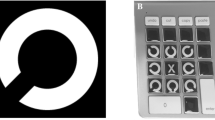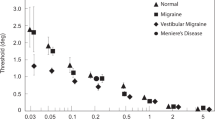Abstract
The aim of the study was to assess the effects of optokinetic stimulation (OKS) on vestibular postural control in migraine patients with recurrent vertigo. 15 patients with vestibular migraine (VM) were enrolled in a posturographic study in eyes open (OE) and eyes closed (CE) condition. The tests were performed between attacks of headache and vertigo at three different time: before, during, and 60 min after OKS. Data of patients with VM were compared with those obtained from two control groups matched for sex and age (15 for each group): (a) normal subjects not suffering from migraine without history of recurrent vertigo (N group); (b) subjects suffering from migraine with no history of recurrent vertigo (M group). Mean sway path velocity and sway area were analyzed. OKS increased the instability in all groups during the stimulus, and both the velocity and area values were higher in M and VM group. However, there was not significant difference between these two groups when stability was examined in OE condition before, during and after OKS stimulation. Conversely, in CE condition a significant greater instability was induced after OKS stimulation only in VM. In particular, post-stimulus values were significantly higher than the pre-stimulus one only in this group, while no significant difference was observed in other groups. A spatial analysis of the sway area evidenced that the instability induced by the OKS in VM group occurred along the direction of OKS. We suggest that this enhanced instability observed after OKS during the intercritical period may be considered an useful marker to support the diagnostic definition of VM in the absence of other vestibular signs.




Similar content being viewed by others
References
Von Brevern M, Zeise D, Neuhauser H, Clarke AH, Lempert T (2005) Acute migrainous vertigo: clinical and oculographic findings. Brain 128:365–374
Pagnini P, Verrecchia L, Giannoni B, Vannucchi P (2003) La vertigine emicranica. Acta Otorhinolaryngol Ital Suppl.75:19–27
Neuhauser H, Leopold M, von Brevern M, Arnold G, Lempert T (2001) The interrelations of migraine, vertigo and migrainous vertigo. Neurology 56:436–441
Kuritzky A, Ziegler DK, Hassanein R (1981) Vertigo, motion sickness and migraine. Headache 21:227–231
Kayan A, Hood JD (1984) Neuro-otological manifestations of migraine. Brain 107:1123–1142
Dieterich M, Brandt T (1999) Episodic vertigo related to migraine (90 cases): vestibular migraine? J Neurol 246:883–892
Weiller C, May A, Limmroth V, Juptner M, Kaube H, Schayck RV et al (1995) Brainstem activation in spontaneous human migraine attacks. Nat Med 1:658–660
Schuerger RJ, Balaban CD (1999) Organisation of the coeruleo-vestibular pathways in rats, rabbits, and monkeys. Brain Res Rev 30:189–217
Halberstadt AL, Balaban CD (2003) Organisation of projections from the raphe nuclei to the vestibular nuclei in rats. Neuroscience 120:573–594
Furman JM, Marcus DA, Balaban CD (2003) Migrainous vertigo: development of a pathogenetic model and structured diagnostic interview. Curr Opin Neurol 16:5–13
Buisseret-Delmas C, Compoint C, Delfini C, Buisseret P (1999) Organisation of reciprocal connections between trigeminal and vestibular nuclei in the rat. J Comp Neurol 409:153–168
Baloh RW (1997) Neurotology of migraine. Headache 37:615–621
Harno H, Hirvonen T, Kaunisto MA, Aalto H, Levo H, Isotalo E et al (2003) Subclinical vestibulocerebellar dysfunction in migraine with and without aura. Neurology 61:1748–1752
Vecchia D, Pietrobon D (2012) Migraine: a disorder of brain excitatory–inhibitory balance? Trend in Neurosci 35(8):507–520
Ophoff RA, Terwindt GM, Vergouwe MN et al (1996) Familial hemiplegic migraine and episodic ataxia are caused by mutations in the Ca2-channel gene CACNL1A4. Cell 87:543–552
Ishizaki K, Mori N, Takeshima T et al (2002) Static stabilometry in patients with migraine and tension-type headache during a headache-free period. Psychiatry Clin Neurosci 56:85–90
Akdal G, Donmez B, Ozturk V, Angin S (2009) Is balance normal in migraineurs without history of vertigo? Headache 49:419–425
Rossi C, Alberti A, Sarchielli P et al (2005) Balance disorders in headache patients: evaluation by computerized static stabilometry. Acta Neurol Scand 111:407–413
Furman JM, Sparto PJ, Soso M, Marcus D (2005) Vestibular function in migraine-related dizziness: a pilot study. J Vestib Res 15:327–332
Lempert T, Neuhauser H (2009) Epidemiology of vertigo, migraine and vestibular migraine. J Neurol 256(3):333–338
Lempert T, Olesen J, Furman J, Waterston J, Seemungal B, Carey J, Bisdorff A, Versino M, Evers S, Newman-Toker D (2012) Vestibular migraine: diagnostic criteria. Consensus document of the Barany Society and the International Headache Society. J Vestib Res 22:167–172
Bles W, Vianney de Jong JM, de Wit G (1983) Compensation for labyrinthine defect examinated by use of a tilting room. Acta Otolaryngol (Stoch). 95:576–579
Guerraz M, Yardley L, Bertholon P et al (2001) Visual vertigo: symptom assessment, spatial orientation and postural control. Brain 124:1646–1656
Headache Classification Committee of the International Headache Society (2004) The international classification of headache disorders. Cephalalgia 24(Suppl. 1):1–60
Monzani D, Genovese E, Marrara A, Presutti L, Gherpelli C, Panzetti P, Forghieri M (2010) Stimulation of cholinergic neurotransmissions enhances the efficacy of vestibular rehabilitation. Acta Otorhinolaryngol Ital 30:11–19
Maioli C (1988) Optokinetic nystagmus: modeling the velocity storage mechanism. J Neurosci 8(3):821–832
Barmack NH, Errico P, Ferraresi A, Fushiki H, Pettorossi VE, Yakhnitsa V (2002) Cerebellar nodulectomy impairs spatial memory of vestibular and optokinetic stimulation in rabbits. J Neurophysiol 87(2):962–975
Pettorossi VE, Errico P, Ferraresi A, Barmack NH (1999) Optokinetic and vestibular stimulation determines the spatial orientation of negative optokinetic after nystagmus in the rabbit. J Neurosci 19(4):1524–1531
Du Lac S, Raymond JL, Seinowski TJ (1995) Lisberger SG Learning and memory in vestibulo-ocular reflex. Annu Rev Neursci 18:409–441
Katoh A, Jindal JA, Raymond JL (2007) Motor deficits in homozygous and heterozygous p/q-type calcium channel mutants. J Neurophysiol 97(2):1280–1287
Author information
Authors and Affiliations
Corresponding author
Rights and permissions
About this article
Cite this article
Panichi, R., Cipriani, L., Sarchielli, P. et al. Balance control impairment induced after OKS in patients with vestibular migraine: an intercritical marker. Eur Arch Otorhinolaryngol 272, 2275–2282 (2015). https://doi.org/10.1007/s00405-014-3179-z
Received:
Accepted:
Published:
Issue Date:
DOI: https://doi.org/10.1007/s00405-014-3179-z




